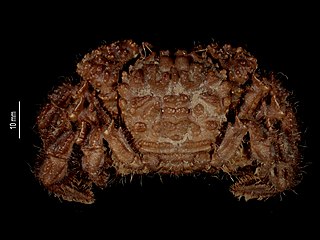
Discoplax is a genus of terrestrial crabs. It is very closely related to the genera Cardisoma and Tuerkayana.

Pseudothelphusidae is a family of freshwater crabs found chiefly in mountain streams in the Neotropics. They are believed to have originated in the Greater Antilles and then crossed to Central America via a Pliocene land bridge. Some species of this family are troglobitic.

Gecarcinus is the type genus of the land crab family Gecarcinidae. They are found in warmer coastal regions of the Americas, including islands in the Caribbean. Four species from oceanic islands were formerly included in Gecarcinus as the subgenus Johngarthia, but are now treated as a separate genus, Johngarthia. While all members of this genus are largely terrestrial, they have to return to the ocean to breed. They are often colourful, with reddish, orange, purple, yellowish, whitish, or blackish being the dominating hues. This has resulted in some species, notably G. quadratus and G. lateralis, gaining a level of popularity in the pet trade.

Scylla is a genus of swimming crabs, comprising four species, of which S. serrata is the most widespread. They are found across the Indo-West Pacific. The four species are:

Vultocinus anfractus is a species of crab, the only species in the family Vultocinidae. It has been found around the Philippines, Vanuatu and New Caledonia, and lives on driftwood. Its discovery forced a reappraisal of the relationships within the superfamily Goneplacoidea, and to the recognition of Mathildellidae, Conleyidae and Progeryonidae as separate families.
Tanaocheles is a genus of crabs, the only genus in the family Tanaocheleidae. It contains two species, T. bidentata and T. stenochilus. The two species were formerly placed in different families, and they were only shown to be related, and placed in a new subfamily, in 2000.

Bellia picta is a species of crab that lives around the coasts of South America, and the only species in the genus Bellia. On the Atlantic coast, it is found in Rio Grande do Sul, Brazil, while on the Pacific coast, it is found off Peru and Chile. It probably lives in burrows and is a filter feeder.
Odontothelphusa is a genus of crabs in the family Pseudothelphusidae, containing the following species:

Potamocarcinus is a genus of crabs in the family Pseudothelphusidae.

Pseudothelphusa is a genus of crabs in the family Pseudothelphusidae, containing the following species:
Smalleyus is a genus of crabs in the family Pseudothelphusidae, containing the single species Smalleyus tricristatus.
Brasiliothelphusa tapajoensis is a species of freshwater crabs in the family Pseudothelphusidae, and the only species in the genus Brasiliothelphusa. It was described in 1986 from specimens caught in the Rio Tapajós in the state of Pará, Brazil. It is listed as Data Deficient on the IUCN Red List.

Epilobocera is a genus of crabs in the family Epiloboceridae. It is the only genus in its family; this taxonomic arrangement follows the revision of the family Pseudothelphusidae by Álvarez and colleagues.
Neoepilobocera gertraudae is a species of cave-dwelling crab from Cuba.
Chaceus is a genus of crabs in the family Pseudothelphusidae, containing the following species:

Karstarma is a genus of karst-dwelling crabs formerly included in Sesarmoides.

Euryxanthops is a genus of crabs in the family Xanthidae. It was originally established in 1983 by Garth & Kim to contain three species of deep-water crabs from Japan and the Philippines - Euryxanthops dorsiconvexus, Euryxanthops flexidentatus and Euryxanthops orientalis. Since then, several more species of this genus have been identified and described, and Euryxanthops currently contains:
Linnaeoxanthus is a genus of crab, whose only species is Linnaeoxanthus acanthomerus. Linnaeoxanthus is the only genus of the family Linnaeoxanthidae.
Hainanpotamon is a genus of freshwater crabs, containing the following species:
Conleyus defodio is a species of crab, the only species in the genus Conleyus and the family Conleyidae. It lives in rubble beds in Guam, and is named after the collector Harry T. Conley.










